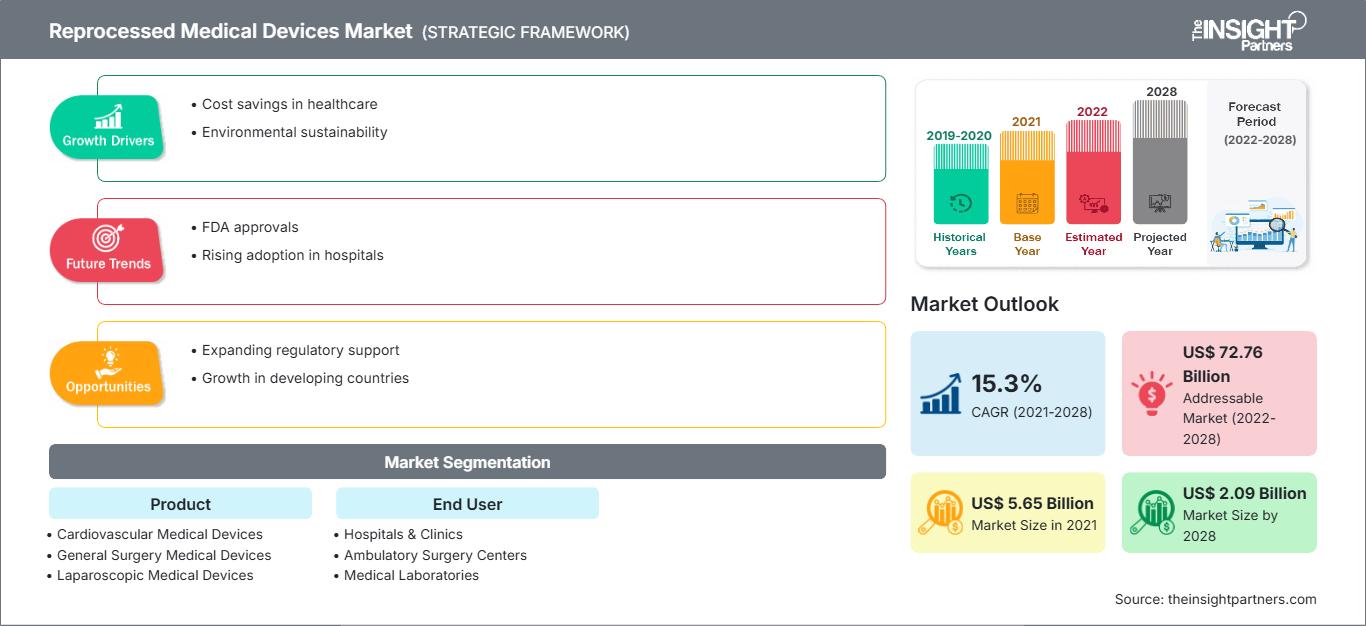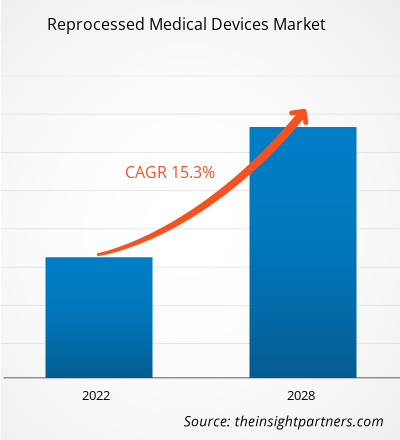Si prevede che il mercato dei dispositivi medici riprocessati raggiungerà i 5.653,87 milioni di dollari entro il 2028, rispetto ai 2.087,36 milioni di dollari del 2021; si prevede una crescita a un CAGR del 15,3% dal 2021 al 2028.
Il riprocessamento è una parte importante del ciclo di vita dei dispositivi medici. Il riprocessamento del dispositivo medico è un processo di pulizia, sterilizzazione, test, rigenerazione, disinfezione e confezionamento, nonché etichettatura di un dispositivo medico usato, scaduto e non danneggiato, per renderlo pronto per il paziente a un costo notevolmente ridotto. Si tratta di un processo o trattamento speciale in preparazione al riutilizzo dei dispositivi medici. L'aumento delle spese ospedaliere per i dispositivi sanitari e l'elevata quantità di sprechi medici stanno trainando la crescita del mercato dei dispositivi medici riprocessati.
Il rapporto offre approfondimenti e analisi approfondite del mercato dei dispositivi medici riprocessati, evidenziando diversi parametri come tendenze di mercato, progressi tecnologici, dinamiche di mercato dei dispositivi medici riprocessati e analisi del panorama competitivo dei principali operatori del mercato dei dispositivi medici riprocessati a livello mondiale. Include anche l'impatto della pandemia di COVID-19 sul mercato in tutte le regioni. La pandemia ha sconvolto le condizioni socioeconomiche di diversi paesi in tutto il mondo. Attualmente, gli Stati Uniti sono il paese più colpito al mondo dall'epidemia di COVID-19, con il più alto numero di casi confermati e decessi, secondo le recenti statistiche dell'OMS. L'elevato numero di casi positivi al COVID-19 ha avuto un impatto negativo sulle economie globali. Si è registrato un calo delle attività commerciali complessive e una crescita di vari settori operanti in tutto il mondo.
La rapida diffusione del COVID-19 ha dato un notevole impulso al settore dei dispositivi medici riprocessati nel 2020. A seguito di una grave carenza di forniture mediche, agenzie di regolamentazione come l'Associazione dei Riprocessori di Dispositivi Medici (AMDR) hanno promosso il riprocessamento delle apparecchiature sanitarie. Secondo AMDR, l'espansione dei programmi di riprocessamento potrebbe aiutare gli operatori sanitari a gestire i costi correlati al COVID-19, a regolamentare meglio le catene di approvvigionamento e a pianificare meglio i rischi futuri. Mentre la pandemia di COVID-19 continua a sconvolgere le economie di tutto il mondo, il crescente volume di rifiuti medici è motivo di grande preoccupazione. Ciò sottolinea la necessità di un riprocessamento efficiente, che può non solo contribuire a soddisfare le carenze di approvvigionamento, ma anche a migliorare la sostenibilità dell'assistenza sanitaria. Tuttavia, con l'inizio dell'epidemia, medici e pazienti sono diventati più preoccupati per la propria sicurezza, aumentando così le preoccupazioni circa il riutilizzo dei dispositivi medici. Ciò ha influito negativamente sulla domanda di dispositivi medici riprocessati. Pertanto, per superare queste preoccupazioni in materia di sicurezza, diverse autorità di regolamentazione della regione hanno reso obbligatorie misure rassicuranti come la sterilizzazione e i test microbiologici sui dispositivi medici riprocessati. Inoltre, il rischio di infezioni negli interventi chirurgici e una sterilizzazione inappropriata dei dispositivi medici possono aumentare i potenziali focolai, ostacolando la crescita del mercato dei dispositivi medici riprocessati. Inoltre, la ricerca e sviluppo sui servizi di riprocessamento è stata sospesa a causa della deviazione dei professionisti per soddisfare la domanda di prodotti correlati alla pandemia. Pertanto, a causa dei fattori sopra menzionati, la pandemia ha avuto un impatto negativo sul mercato dei dispositivi medici riprocessati.
Personalizza questo rapporto in base alle tue esigenze
Potrai personalizzare gratuitamente qualsiasi rapporto, comprese parti di questo rapporto, o analisi a livello di paese, pacchetto dati Excel, oltre a usufruire di grandi offerte e sconti per start-up e università
Mercato dei dispositivi medici riprocessati: Approfondimenti strategici

-
Ottieni le principali tendenze chiave del mercato di questo rapporto.Questo campione GRATUITO includerà l'analisi dei dati, che vanno dalle tendenze di mercato alle stime e alle previsioni.
Approfondimenti di mercato
La crescente importanza della riduzione dei rifiuti sanitari guida il mercato globale dei dispositivi medici riprocessati
Il riprocessamento è una pratica comune negli Stati Uniti, dove gli ospedali preferiscono riprocessare i dispositivi monouso per ridurre al minimo i rifiuti sanitari. Circa il 45% degli ospedali ha accordi di riprocessamento con aziende terze specializzate nel riprocessamento di dispositivi medici negli Stati Uniti.
Secondo gli studi, il riutilizzo dei dispositivi medici è un'iniziativa più ecologica, poiché produce meno rifiuti sanitari, il che è vantaggioso per l'ambiente. I rifiuti sanitari intasano le discariche e diventano costosi i servizi di smaltimento dei rifiuti organici. Rispetto allo smaltimento dei rifiuti solidi convenzionali, i rifiuti sanitari regolamentati (RMW) costano circa 5-10 volte di più, con conseguente aumento della spesa. Diversi operatori sanitari hanno osservato che i dispositivi riutilizzabili e monouso sono pressoché comparabili e che un corretto ritrattamento dei dispositivi non ha conseguenze negative per i consumatori.
I rifiuti riutilizzabili (RMW), spesso noti come "rifiuti in sacchi rossi", rappresentano una spesa per i rifiuti che in genere costa agli ospedali dalle 6 alle 10 volte di più rispetto ai rifiuti solidi convenzionali. Grazie a iniziative sempre più numerose, il 95% dei dispositivi viene ritrattato annualmente anziché essere smaltito in discarica al termine del ciclo di vita. Acciaio inossidabile, alluminio, titanio, oro, policarbonato e poliuretano sono tra le altre materie prime ritrattabili che finiscono nei rifiuti riutilizzabili (RMW) di un ospedale. Alcuni ospedali hanno sottratto alle discariche oltre 8.000 libbre di RMW ogni anno grazie al ritrattamento, mentre i sistemi più grandi possono riciclarne oltre 50.000 libbre. Pertanto, la crescente importanza della riduzione al minimo dei rifiuti sanitari sta guidando la crescita del mercato globale dei dispositivi medici riprocessati.
Approfondimenti basati sul prodotto
In base al prodotto, il mercato dei dispositivi medici riprocessati è segmentato in dispositivi medici cardiovascolari, pinze per biopsia gastroenterologica, dispositivi di fissazione esterna ortopedica, dispositivi medici laparoscopici, dispositivi medici per chirurgia generale, dispositivi non invasivi e altri. Nel 2021, il segmento dei dispositivi medici cardiovascolari ha rappresentato una quota maggiore del segmento di mercato complessivo dei prodotti. Inoltre, si prevede che il segmento dei dispositivi cardiovascolari registrerà il CAGR più elevato sul mercato durante il periodo di previsione, a causa del crescente peso di varie malattie coronariche, come ictus e cardiomiopatia.
Approfondimenti basati sull'utente finale
In base all'utente finale, il mercato dei dispositivi medici riprocessati è segmentato in ospedali e cliniche, centri chirurgici ambulatoriali, laboratori medici e altri. Il segmento ospedali e cliniche ha detenuto la quota maggiore del segmento di mercato degli utenti finali nel 2021 e si prevede che lo stesso segmento registrerà il CAGR più elevato del 16,9% del mercato dei dispositivi medici riprocessati durante il periodo di previsione.
Gli operatori del mercato dei dispositivi medici riprocessati adottano strategie organiche come il lancio e l'espansione dei prodotti per espandere la loro presenza e il portafoglio prodotti in tutto il mondo e soddisfare la crescente domanda.
Approfondimenti regionali sul mercato dei dispositivi medici riprocessati
Le tendenze regionali e i fattori che influenzano il mercato dei dispositivi medici riprocessati durante il periodo di previsione sono stati ampiamente spiegati dagli analisti di The Insight Partners. Questa sezione illustra anche i segmenti e la distribuzione geografica del mercato dei dispositivi medici riprocessati in Nord America, Europa, Asia-Pacifico, Medio Oriente e Africa, America meridionale e centrale.
Ambito del rapporto di mercato sui dispositivi medici riprocessati
| Attributo del rapporto | Dettagli |
|---|---|
| Dimensioni del mercato in 2021 | US$ 5.65 Billion |
| Dimensioni del mercato per 2028 | US$ 2.09 Billion |
| CAGR globale (2021 - 2028) | 15.3% |
| Dati storici | 2019-2020 |
| Periodo di previsione | 2022-2028 |
| Segmenti coperti |
By Prodotto
|
| Regioni e paesi coperti |
Nord America
|
| Leader di mercato e profili aziendali chiave |
|
Densità degli operatori del mercato dei dispositivi medici riprocessati: comprendere il suo impatto sulle dinamiche aziendali
Il mercato dei dispositivi medici riprocessati è in rapida crescita, trainato dalla crescente domanda degli utenti finali, dovuta a fattori quali l'evoluzione delle preferenze dei consumatori, i progressi tecnologici e una maggiore consapevolezza dei benefici del prodotto. Con l'aumento della domanda, le aziende stanno ampliando la propria offerta, innovando per soddisfare le esigenze dei consumatori e sfruttando le tendenze emergenti, alimentando ulteriormente la crescita del mercato.

- Ottieni il Mercato dei dispositivi medici riprocessati Panoramica dei principali attori chiave
Per prodotto
- Dispositivi medici cardiovascolari
- Bracciali per la pressione sanguigna/Bracciali per laccio emostatico
- Dispositivi di stabilizzazione e posizionamento cardiaco
- Cateteri per elettrofisiologia diagnostica
- Cavi per elettrofisiologia
- Dispositivi medici per chirurgia generale
- Dispositivi per gonfiaggio palloncini
- Sacche per pressione infusionale
- Dispositivi medici laparoscopici
- Trocar e componenti endoscopici
- Bisturi armonici
- Dispositivi di fissazione esterna ortopedica
- Pinze per biopsia gastroenterologica
- Dispositivi non invasivi
- Guanti per TVP
- Cavi ECG
- Polso Sonde per ossimetro
- Tappetini per trasferimento ad aria
- Abbigliamento ad ultrasuoni
- Palloncini e cestini per estrazione
- Accessori per circuiti
- Lenti ottiche
- Altri dispositivi non invasivi
- Altri
Per utente finale
- Ospedali e cliniche
- Centri chirurgici ambulatoriali
- Laboratori medici
- Altri
Profili aziendali
- Medline Industries, Inc.
- Arjo Medical Devices
- Stryker Corporation
- Innovative Health
- Teleflex Incorporated
- Johnson and Johnson Services, Inc.
- 3M
- Currie Medical Specialities, Inc
- STERIS plc
- Cardinal Health Inc.
- Vanguard AG
- Analisi storica (2 anni), anno base, previsione (7 anni) con CAGR
- Analisi PEST e SWOT
- Valore/volume delle dimensioni del mercato - Globale, Regionale, Nazionale
- Industria e panorama competitivo
- Set di dati Excel
Report recenti
Rapporti correlati
Testimonianze
Motivo dell'acquisto
- Processo decisionale informato
- Comprensione delle dinamiche di mercato
- Analisi competitiva
- Analisi dei clienti
- Previsioni di mercato
- Mitigazione del rischio
- Pianificazione strategica
- Giustificazione degli investimenti
- Identificazione dei mercati emergenti
- Miglioramento delle strategie di marketing
- Aumento dell'efficienza operativa
- Allineamento alle tendenze normative






















 Ottieni un campione gratuito per - Mercato dei dispositivi medici riprocessati
Ottieni un campione gratuito per - Mercato dei dispositivi medici riprocessati